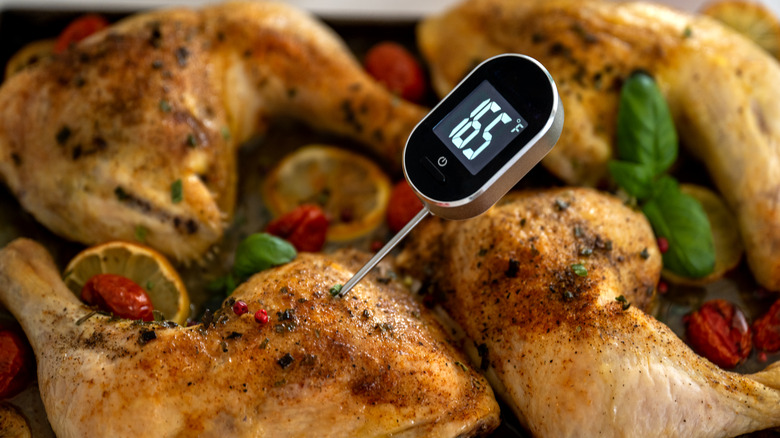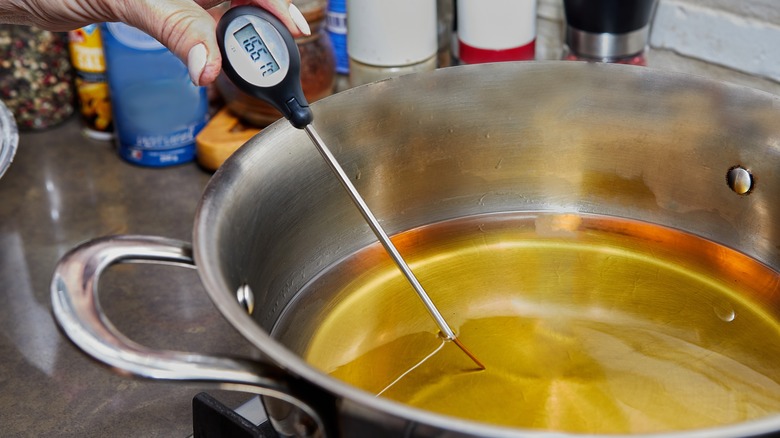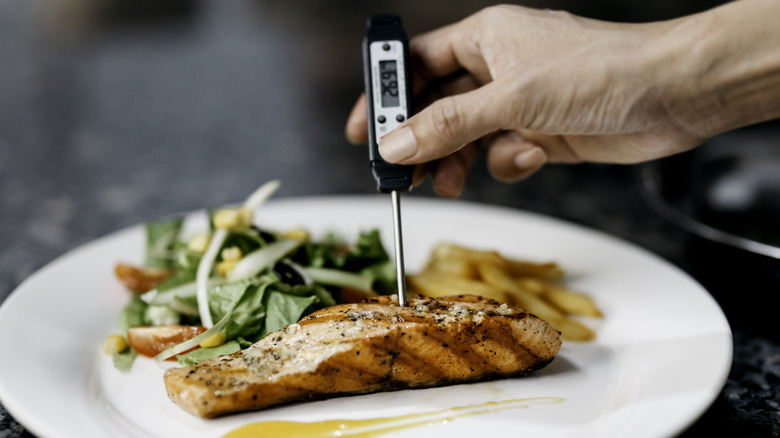How To Make Sure Your Meat Thermometer Is As Accurate As Possible
Meat thermometers are a useful kitchen tool that allows you to know exactly when your food has reached its optimal temperature. There's nothing worse than slicing into a chicken to find it tough and leathery or pink and underdone. Meat thermometers remove most of this guesswork. However, you want to make sure that your thermometer is getting an accurate reading. Undercooked food can lead to potential food-borne illnesses. According to the USDA, poultry must reach an internal temperature of 165 degrees Fahrenheit, and pork must reach a temperature of 160 degrees, for instance.
So, how can you ensure that you are getting an accurate reading? Don't make this placement mistake with your meat thermometer. You want to insert it into the thickest part of your meat, whether chicken, pork, or beef. This may go against popular advice to always check the temperature at the center. While it's true that meats do cook from the outside inward, many meats aren't symmetrical. You have bone, fat, and other connective materials to consider.
What you're actually trying to find is the temperature of the coldest part of the meat. This is generally where the meat is at its thickest, as it takes longer to cook. For meats like hamburgers or chicken breasts, you can put the thermometer through the side of the meat to get an accurate reading.
It's also important to make sure that you have an accurate meat thermometer, following the manufacturer's recommendations to test or calibrate it. Of course, if a manual isn't handy, there are some easy tips to check if your thermometer is broken.
How to check for accuracy
As with anything, thermometers have the ability to fail, and the last thing you want is an inaccurate meat thermometer ruining your dinner. Fortunately, by testing two different extremes, you can make sure that your thermometer is reading correctly at both ends of the temperature spectrum. For a quick check, you're going to measure both ice water and boiling water. As many of us learn in science class, water has both a boiling and freezing point — 32 degrees and 212 degrees Fahrenheit, respectively.
Fill a glass full of both water and ice. You're going to want to make sure that the water is properly chilled by filling as much ice as possible into the glass. This should effectively lower the temperature to freezing. Let your water cool down for a few minutes, and then get a reading of the glass of water with the thermometer. An accurate thermometer should register the temperature as freezing.
Following this same logic, you will boil a pot of water on the stove to a rolling boil. You want to be careful to avoid letting any water splash your hand. Always practice proper safety as recommended by the Phoenix Society For Burn Survivors. The thermometer should register the boiling pot of water at 212 degrees if it is accurate. From there, you can make appropriate changes.
How to recalibrate your thermometer
If your thermometer is inaccurate, then there are a couple of things that you can try. Depending on the type of thermometer, you can always try to recalibrate it to read the right temperature. Truthfully, it's probably easier to calibrate a non-digital thermometer than a digital thermometer. Non-digital thermometers have something called a calibration nut. It's located near the head of the thermometer and allows the user to adjust the reading manually.
The process for this is rather simple. You would turn the calibration nut until it reached the proper temperatures in the tests mentioned, either 32 or 212 degrees. Digital thermometers are a bit more tricky as you'll need to reset the thermometer. Generally, each manufacturer has their own instructions for how to recalibrate a digital thermometer, so there's not a catch-all in this case. Unfortunately, some digital thermometers can't be recalibrated.
Your best bet would be to reach out to your manufacturer for instructions or to see if they can offer a replacement. Alternatively, if you know how many degrees your thermometer is inaccurate, you can always adjust accordingly. However, you should keep a check on your thermometer in case the inaccuracies in its readings grow.


